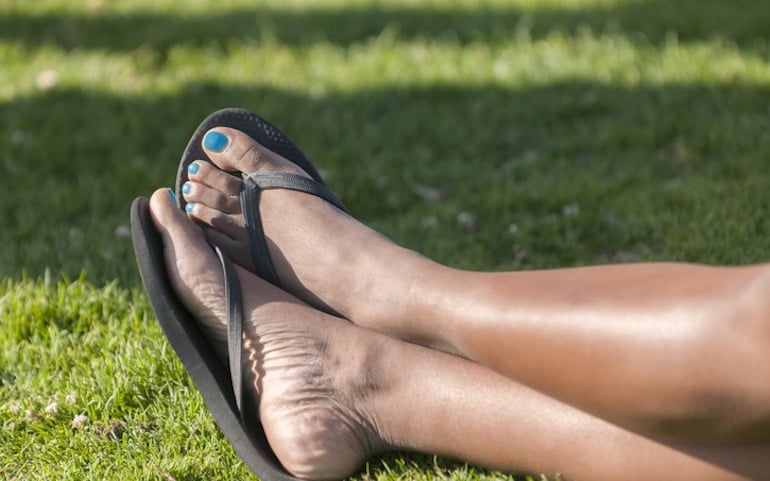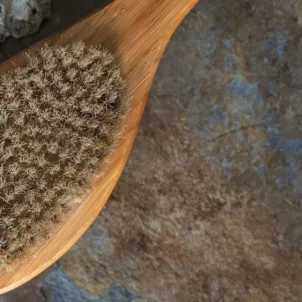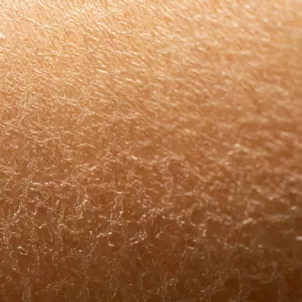Medically Reviewed By
Gaby Vaca-Flores, RDN, CLE
Registered Dietitian Nutritionist
Three doctors share how to heal dry, cracked feet for softer heels, soles, and toes. Plus: What causes dry feet to begin with?
I have a confession: My feet are really, really dry. Over the years, I’ve tried dozens of treatments—from peels and creams to foot files and even a fish pedicure in Bali—hoping to fix my cracked feet… and yet I’m still on the hunt for the ultimate solution.
Ready to get to *the bottom* of my problem and learn how to heal dry feet for good, I asked a dermatologist and two podiatrists for some desperately needed tips.



why are my feet so dry?
Tsippora Shainhouse, MD, FAAD, a board-certified dermatologist based in Beverly Hills, says that there are three main causes of dry feet:- weather/environmental conditions
- friction + poor footwear
- insufficient skincare
Weather
First, you may notice that your feet get especially dry in the winter and/or summer. “Cool, dry winters with moisture-sucking electric heaters, wool socks, boots, and synthetic tights wick moisture from the skin, leading to dryness,” Dr. Shainhouse explains. Then, come summertime, hot and dry weather can lead to skin dryness as well.
Friction
Next, since too much friction and pressure can exacerbate dry, scaly feet, your choice of footwear comes into play. In particular, “Backless shoes and flip flops provide minimal foot support, which increases pressure on the heels and surrounding skin,” Dr. Shainhouse continues. “They also cause your heels to rub on the back edges of the shoe.” As a result, she concludes, wearing open shoes and shoes without socks “can force your skin to thicken and toughen up as a means of protection.” Further, Hillary Brenner, DPM, a board-certified podiatric surgeon based in NYC, adds that a lifestyle that requires standing for long periods of time can also contribute to dry, cracked feet.Inadequate Skincare
Then, the wrong products and a lack of proper care could also be what causes dry, cracked feet. “Not moisturizing dry feet to hydrate and soften the skin—as well as helping to strengthen and protect the skin barrier—can lead to skin over-dryness, thickening, and cracks,” Dr. Shainhouse explains. Plus, when it comes to healing dry feet, sooner is always better. “Not dissolving callouses and thick patches before they become too thick and inelastic can lead to thickening and cracks [that are more difficult to repair],” she warns.Additional Causes of Dry Feet
Dr. Brenner adds that other causes of dry feet include:- poor circulation
- a lack of hydration
- blood sugar imbalances
- vitamin deficiencies
- certain medications

How to Heal Dry, Cracked Feet
Now, for the best part: Here are the best ways to heal dry feet.1. Exfoliate
First, Dr. Brenner recommends exfoliating your feet two to three times a week. As she puts it, “The idea is to get rid of as much dryness and layers of skin as possible so you can get the best bang for your buck with your moisturizer.” (By that, she means your foot lotion won’t have to penetrate through extra layers to get to work.) She suggests using an exfoliating foot scrub rather than a pumice stone since fungus can potentially grow in a dark, moist environment. Dr. Splichal particularly recommends finding scrubs that pack exfoliating acids—including lactic acid, salicylic acid, and glycolic acid—or papaya enzymes. However, if you do prefer to use a callus remover or foot file, Dr. Shainhouse notes that doing so can certainly make calluses and hard patches less tender in the short term. However, she says that “the skin will likely thicken back up if the trigger (e.g., rubbing, friction, wearing flip flips) continues.”2. Use a Foot Peel
If you’ve ever seen or used a foot peel before, you know how oddly satisfying it is to witness layers (upon layers) of dead, dry skin shed off. Otherwise, if you’re new to foot peels, consider trying one out to jumpstart your regimen. Here’s what to expect:- slip on a plastic bootie doused in exfoliating ingredients
- wait about an hour or so
- waddle off to the bathtub to rinse off the solution
3. Soak Your Feet
Dr. Brenner recommends another pro tip to fix cracked feet: Soaking them two to three times per week. While an Epsom salt soak should do the job, you can also look for a dedicated foot soak product. She particularly recommends one that contains Dead Sea salt, which is effective yet still gentle enough for super sensitive skin types. (If you ever make it to Israel or Jordan, don’t pass up the chance to float in the healing water for full-body benefits!)
4. Moisturize
Now that you have a fresh canvas to work with, it’s time to moisturize. Since the skin on your feet is much thicker than that on your body or face, a targeted foot lotion is your best bet. Dr. Shainhouse and Dr. Splichal both recommend products that contain urea, which has water-binding properties to hydrate and soften skin. Also, keep your eye out for emollients such as shea butter and colloidal oatmeal. For best results, moisturize your feet once or twice daily. Tip: Since we know that water binds to water, aim to slather on foot lotion while your skin is still damp after showering. Then, to go the extra mile, both doctors also recommend wrapping your feet in plastic wrap and wearing socks overnight to seriously lock in moisture.5. Upgrade Your Footwear
Since we learned that poor support and the wrong choice of footwear can cause dry feet, it’s probably time to rethink your footwear. “Wear protective barriers and supportive, well-fitting shoes in order to prevent recurrences,” Dr. Shainhouse advises. If and when possible, she recommends:- wearing sweat-absorbent socks
- not wearing flip flops, sandals + sling-back shoes too often
Final Thoughts
All in all, if you’re committed to fixing cracks and dry feet for good, Dr. Brenner advises that the best way to approach it is to follow a dedicated regimen like you would for your face. While figuring out how to heal dry, cracked feet is a process, these pro tips should lead you in the right direction. However, if you’re not experiencing desired results, you may want to see a podiatrist or dermatologist for a medical-grade treatment. As for my own dry heel woes? I’ll be diving into these treatments—you guessed it—feet first.More like this









